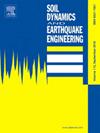Nonlinear stiffened inertial amplifier tuned mass friction dampers
IF 4.2
2区 工程技术
Q1 ENGINEERING, GEOLOGICAL
引用次数: 0
Abstract
The nonlinear stiffened inertial amplifier tuned mass friction damper (NSIATMFD) is introduced in this paper to address the limitations of the conventional tuned mass dampers such as narrow frequency ranges and limited adaptability. In addition, three more novel dampers, such as nonlinear compound stiffened inertial amplifier tuned mass friction dampers (NCSIATMFD), nonlinear nested stiffened inertial amplifier tuned mass friction dampers (NNSIATMFD), and nonlinear levered stiffened inertial amplifier tuned mass friction dampers (NLSIATMFD), are introduced by integrating stiffness and mass amplification mechanisms to increase their vibration reduction capacities. These novel dampers are applied at the top of structures to control their dynamic responses. Newton’s second law is followed to derive the governing equations of motion of the controlled structures. and optimisation strategies are utilised to derive the exact closed-form expressions for the optimal design parameters of these dampers. The transfer function is developed to derive the frequency domain responses by considering harmonic and random excitations. The frequency domain responses are further validated through numerical studies conducted using the Newmark-beta method and near-field earthquake records. Compared to the conventional tuned mass dampers (TMD), the proposed dampers achieve vibration reduction improvements of 24.24 %, 24.64 %, 23.92 %, and 24.54 %, respectively. The integration of stiffness elements significantly extends the frequency control range, while the frictional damping element enhances energy dissipation capabilities. These results establish the novel designs as effective solutions for dynamic environments, offering robust and adaptive vibration mitigation for structures exposed to diverse excitations, including seismic loads. This research provides a significant advancement in TMD technology for modern engineering applications.
求助全文
约1分钟内获得全文
求助全文
来源期刊

Soil Dynamics and Earthquake Engineering
工程技术-地球科学综合
CiteScore
7.50
自引率
15.00%
发文量
446
审稿时长
8 months
期刊介绍:
The journal aims to encourage and enhance the role of mechanics and other disciplines as they relate to earthquake engineering by providing opportunities for the publication of the work of applied mathematicians, engineers and other applied scientists involved in solving problems closely related to the field of earthquake engineering and geotechnical earthquake engineering.
Emphasis is placed on new concepts and techniques, but case histories will also be published if they enhance the presentation and understanding of new technical concepts.
 求助内容:
求助内容: 应助结果提醒方式:
应助结果提醒方式:


